This article is a repost. The original article was published on RakeAround’s blog
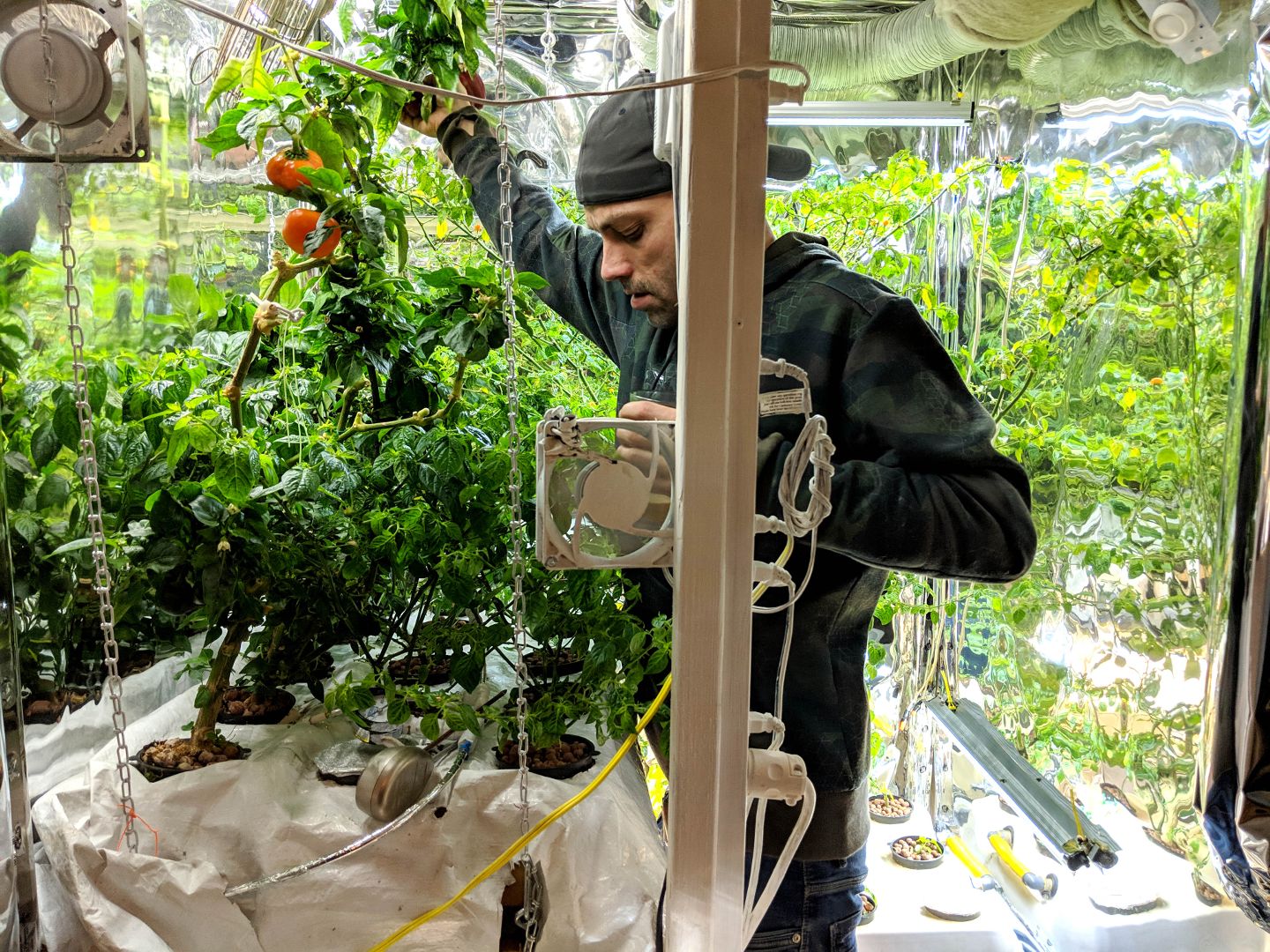
Urban Agriculture Story: From NASA science to indoor gardening with Vertiponic
by Dominique Bernier,
This article is a repost. The original article was published on RakeAround’s blog

by Dominique Bernier,
Growing food in Space requires doing more and better with less. To achieve this, it was necessary to deconstruct the principles of agriculture and to question the importance of soil and water. NASA sponsored research showed that it can be done using high pressure aeroponics (HPA). Vertiponic has decoded some of this research and pushed it further to develop their own high-efficiency indoor garden.
This story began when I went to visit Vertiponic in Montreal, curious to learn about the Aji Charapita, a rare and expensive hot pepper they grow. I was blown away by what I discovered, as you can see in the clip below.
It turned out that the real deal was not this variety of pepper called the mother of all chilis, but how Vertiponic was growing them. It’s not exaggerating to say that it has the potential to completely disrupt the way we grow organic foods in an urban environment.
Vertiponic’s indoor garden, which looks a bit like a Space shuttle pod from the inside, can grow high-yield organic foods on a small surface using HPA. Although the current design may not have yet been refined for the mass market, it could become the new must-have home appliance in the near future.
Unlike most of the indoor gardens currently available on the market, which may serve more decorative purposes than productivity, Vertiponic’s garden can drastically reduce the cost of buying fresh food. It also answers many other problems such as traceability, sustainability, food safety, and food accessibility.
It can grow 36 crops on 16 sq.-ft., including extra space for side crops like micro-greens. There’s a 2 sq.-ft. space that remains available at all time for harvest and maintenance, as one of the growth tables can be moved from side to side when required. In this concept, the yield value is measured by cubic feet instead of square feet, simply because it better reflects the efficiency of the space used.
On average, each crop space can produce up to 10 pounds of fruits or greens per year (depending on the type of crop: e.g., Lettuce, 12 lbs/y; King of the North peppers 11 lbs/y, Doe Hill peppers 10 lbs/y, Melon radish 5 lbs/y). When considering the market price of each crop, the yearly value of food grown in this 128 ft3 space can vary from $500 to over $1000. Because Vertiponic grows Aji Charapita peppers, their average revenue per ft3 is skyrocketing. Market price per kilo for this hot pepper can be up to $25000. Their space can produce 400 grams of it yearly, making their yield value flirting around $78.00/ft3.
The indoor garden HPA system is calibrated in a way that prevents nozzles from clogging, for minimum maintenance and maximum performance. Water used for the mist has a density of 4ppm. It could be entirely powered by a 5,000 watts solar panel or 2,000 watts wind mill, making it completely self sufficient. Heat generated from the lights is recuperated to warm the apartment or house during winter and pushed outside during summer, similarly to what a dryer does.
Another particular aspect of this garden is its cost of research and development. While major tech companies like Microsoft, Tencent, and Intel are injecting millions of dollars in projects to develop efficient ways to grow food assisted by AI, Vertiponic has generated similar or even superior results from a budget below $5,000 (without artificial intelligence support).
This small startup was created by JF, a construction worker with a strong interest in growing plants. His spouse Noemi helps him with communications by promoting his work on Vertiponic website and social media.
JF explained that he didn’t have the opportunity to get a university education. However, his passion for science, engineering, and biology, his curiosity, as well as his hunger for knowledge turned out to be the best teachers. At the age of 18, he already started to experiment with high-efficiency growth techniques with medicinal cannabis plants.
In 2002, his own designed strain of organic medicinal cannabis earned him the first place at the Quebec Cannabis Cup. His award-winning strain, called the Magic Crystal, was a cross between a White Widow and an Orange Bud. From there, cloning became his specialty.
“With what I know today, I would need only 4 quality plants and a 600 watts light to produce 400 high-quality clones per plant in less than 2 weeks”, JF said proudly.
Such skills became highly valuable in Canada since October 17, 2018, and you may wonder: why JF is not a full-time professional cannabis grower? “The social impact between growing cannabis and food is not the same”, JF said. Already in 2003, he noticed a change in the cannabis industry. The hype around scientific and medical purposes of growing cannabis switched to interests for entertainment and product promotion.
For JF, it is the lack of seriousness and concrete social objectives that have pushed him aside. An industry solely in search of high profits from entertainment was not exactly what he was looking for. His primary interests were in researching, developing, and creating new growth techniques. Therefore, he decided to continue what he had started but changed from cannabis to food crops. If you think about it, this is far from being a bad move. This field is in terrible need of new, sustainable and economically viable innovations.
JF understands that the traditional agricultural model reached its limits. That’s why he wanted to create a system that offers the highest yields at the lowest cost, using a minimum of natural resources, human resources, and space.
“High margin can be generated in agriculture if using the right science. And you don’t need Roundup, underpaid foreign workers or an army of volunteers to achieve that.” -JF
Everything he has learned in the cannabis industry was applied to food crops like tomatoes, bell peppers, hot peppers, cucumbers, lettuce, and many others. To carry out his project, HPA became his main growing technique and his research subject.
High Pressure Aeroponics is a plant growing process that uses air as a substrate to feed the root systems. To prevent them from drying out, the roots are sprayed by an intermittent mist.
“NASA sponsored research has shown that HPA is the most performant and sustainable method to grow food that has ever been developed and it’s simply indisputable.” – JF
According to Richard Stoner, the NASA’s researcher who developed the method in the 80s, HPA is using up to 98% less water than traditional agriculture. As an example, for every 1000 litres used in traditional agriculture, aeroponics would use only 20 litres to reach the same results.
The same NASA study shows that Aeroponics reduce fertilizer usage by 95% compared to traditional agriculture, making it very competitive with other popular hydroponic technics. « If you compared with hydroponic deep water current (DWC) in which you need at least 15 litres of water per plant, my aeroponics system has a reservoir of 40 litres for 36 plants, reducing significantly operational costs and the quantity of nutrients needed”, JF said. “Aeroponics is the only method that enables you to work with high-quality nutrients, reach high efficiency and get optimal results, at the lowest costs”, he added.
What makes JF’s aeroponics system unique is the way he was able to apply what he had learned from NASA’s HPA research into its own calibration, which includes:
water ppm level
size of each droplet in the mist
droplet pH level
the dosage of nutrients in each droplet
the frequency of the mist sprayed
duration of each spray
PSI level
“These settings are Vertiponic’s secret weapon”, JF explained. By experimenting with his aeroponics configuration, JF learned that the faster a plant grows, the better the quality of the crop and its nutritional value. This is particularly noticeable through the taste and aromas that the fruits give off.
With HPA, it takes 15 seconds for the plant to detect nutrients in the mist and about a day to absorb what it needs. Calibration of a droplet is calculated in microns (1 micron = 0.001millimetre) and it is something JF takes really seriously.
The better the mist quality, the better the productivity of the plant will be. Currently, he’s working on downsizing his droplets to get a bit closer to 50 microns, which NASA researchers established as the size to reach optimal results. However, it is an ongoing debate, he noted.
At this moment, his current calibration prevents all nozzles from clogging and had reduced significantly maintenance time and cost. It’s something that very few people or systems can brag of having accomplished, JF said.
Would reaching 50 microns impact nozzles performance? He doesn’t have the answer yet, as not enough people have crossed this territory and documented it so far. He’s in a position where part of the knowledge on the matter is created by himself. For now, he understands how and why his crops react so well to his specific calibration, making it one of the most valuable pieces of information he developed.
“With the size of my droplets, my system is performing very well, nozzles stay clean, maintenance effort is low and plants are thriving like crazy!”- JF
JF is shy of discussing results with people employing traditional agriculture methods, as the gap between what the science knows and what the agri-food industry does becomes too wide. He often experiences systemic negation, bashing or is accused of lying and cheating. Nonetheless, he persists in sharing lots of his knowledge so people could understand the possibilities of HPA. You could also give it a try by consulting Vertiponic’s 7 Steps for Indoor High Pressure Aeroponics.
“I still don’t understand why aeroponics is not widely taught in agricultural schools and universities in North America”, JF said. “This method produces 30% more and faster than hydroponic, and in my system, my crops require no fungicides, pesticides, and algicides”, he added.
All nutrients used are mineral and organic based and no chemicals are required. JF explained that he may use Boron (5B) at one point, but on specific occasions and for certain types of crops only, such as strawberries.
To feed plants adequately, JF developed his own soup for his aeroponics system using nutrients from Advance. What he calls soup is a personalized combination of nutrients for crops, which feed them through the mist.
Here are some examples of crop productivity results from his HPA system:
Beetroots: 160g in 6 weeks
Blackberry plant: grew up to 17 ft and took 8 weeks to produce berries
Cucumber plant: produced 1-2 fruits per week
Doe Hill pepper plant: 100 to 200 peppers per year
Espelette pepper plant: produced over 400 peppers per year (avg market price $12/lbs)
King of the North pepper plant: 50 to 100 peppers per year
Iceberg lettuce: 5 weeks from seed to harvest
Melon radishes: 180g in 5 weeks from seeds to harvest
Purple radishes: 60g in 3 weeks from seeds to harvest
Tobacco: 3 weeks from seed to ready-to-dry leaves)
To get a better visual, have a look at Vertiponic Flikr account.
Vertiponic aims to create a variety of peronalized HPA installations and services to answer the needs of many types of client. Such products or services could:
help increase or maximize existing urban farms yields
support non-profit organizations to grow food efficiently and at a low cost for their clientele
enable restaurateurs to reduce their food costs
provide turnkey solutions to entrepreneurs wishing to start their urban farming projet.
To demonstrate the power of cloning and the system productivity, JF plans to make the Aji Charapita, a rare plant growing in Peru, as common as basil by producing up to 1000 clones per month. It is also a way to show that his productivity value per ft3 can be equal or superior to those of big players like Square Roots, AeroFarm or Bowery Farming.
He already started and you can see in the video below how he transformed the indoor garden pod into a mini Peruvian jungle.
Continuing the research and development on the indoor garden remains a priority. “This type of product can really scale and could become as useful as any home appliances we know”, JF said.
The indoor garden pod could have different sizes. The main benefit of increasing the size (if you have space) is that the value of the garden yield becomes well above the initial cost, the operational cost, and the effort required.
The purpose of the indoor garden pod goes beyond efficiency and productivity. It’s about making it accessible to as many people as possible. Combined with a monitoring software or AI support, it would have the potential to make each of us the most sustainable and productive farmers in the history of mankind.
“If my system would be supported by a monitoring software or AI, a 1,600 ft3 indoor garden space or greenhouse would easily make a family of 4 completely self-sufficient in fruits and vegetables.” -JF
Other crops will be tested shortly, such as exotic fruits, avocado trees… and coffee! Now imagine this: people easily growing their own coffee or growing coffee locally. The potential and the opportunities are real. It would represent a huge relief on the supply chain and a considerable drop in our carbon footprint. This is what happens when you mix Space science and agriculture: the sky really is the limit.
Do you have an inspiring urban agriculture story to tell or innovative ideas to share? Contact us or leave a comment below!
You’re an urban food grower with harvests to sell? Let us help you reach buyers in your city!
The practice of urban agriculture is growing rapidly. People like JF are true ambassadors in promoting the benefits of growing in cities and E-commerce can play a role in what they do.
Online shopping has reshaped our buying habits, especially for city dwellers. The web gives us the ability to sell products at a low cost with less effort than ever.
As e-commerce-for-all is still relatively new, RakeAround provides a simplified online selling process to help small-scale urban food producers generate revenues, without the burden of attending farmer’s markets or spending too much time searching for customers.
Proximity buyers can find their products in one click, using the “What’s near me” feature. Our user experience is designed to make buying local products simpler, fresher and faster by considering both producers and consumers’ busy urban lifestyles.
Dominique is the co-founder of RakeAround. For him, demographic trends, the democratization of technology and the personalization of food will shape food systems of the 21st century.
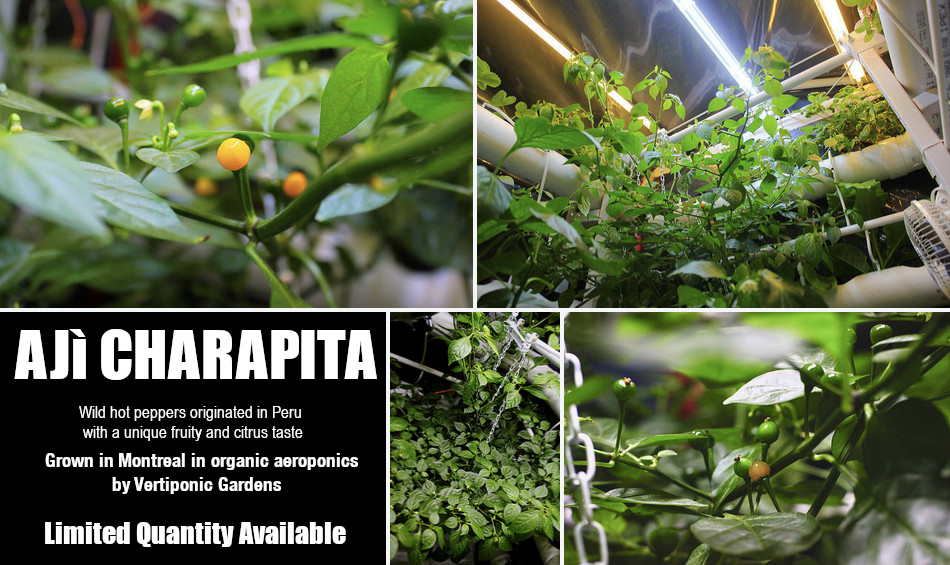
We are having so much fun growing our first Aji Charapita hot pepper plant in outdoor aeroponics this season. From the tiny fragile seedling that was dropping its leaves to this majestic bush full of pods that are now gorgeously turning yellow, we have been falling in love.
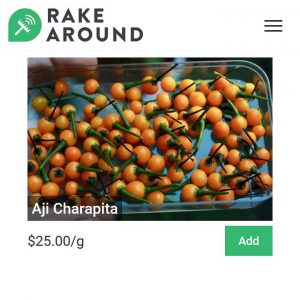 It is so rewarding to see the pods maturing. Called the “mother of all chilis” and known to be the rarest and most exclusive hot pepper in the world, Aji Charapita has a unique fruity flavor and a Scoville heat ranging between 30,000 and 100,000 SHU. Our original seed is 100% pure F1, having been harvested in the peruvian jungle itself.
It is so rewarding to see the pods maturing. Called the “mother of all chilis” and known to be the rarest and most exclusive hot pepper in the world, Aji Charapita has a unique fruity flavor and a Scoville heat ranging between 30,000 and 100,000 SHU. Our original seed is 100% pure F1, having been harvested in the peruvian jungle itself.
Quickly visit us on RakeAround to get them fresh while they last
All summer we gave this special plant the best we possibly could. Natural light, shelter under the greenhouse, good air circulation, high pressure aeroponics with perfect micron mist on the roots and all the way organic Advanced Nutrients feeds. At the end of the outdoor season, we added double layers on the greenhouse walls and Sunblaster orange neons/LED additional lightings.
We recently found out from peruvian friends a little more about all the myths surrounding this amazing plant. The wild Aji Charapita is a very ancestral variety of Capsicum chinense native to the peruvian jungle. Many peppers we know today may have evolved from it thus the name “mother of all chilis”. It needs very delicate conditions like hot springs to survive in winter.
Unfortunalty for it, bad people found out they could use it to increase their profit in the coca extraction. Because of this and its unique flavor, the wild variety started being abusively harvested to the brink of extinction. This is why it became rare and its culture is now forbidden in Latin America.
Learning that fact made us feel sorry that this special plant could go extinct for such a destructive industry. This motivated us to double our effort in order to propagate the plants we take care of right now and share them as much as we can. More people should know its worth and how amazing it tastes. And to preserve the strand we also won’t devaluate it or sell open pollinated seeds. Clones will be available during the winter and spring.
Update:
The plants and aeroponic setup is now back indoor under the sodium light and the mother plant is still full of pods and flowers. We are also happy to announce that JF successfully cloned a dozen babies. With God’s help we may have a solid Aji Charapita winter harvest.
We have been experimenting aeroponics and photo documenting our progress for more than a year now. During the 2017 winter, our vertical setup was in a countryside home with a majestic 14 feet high solarium.
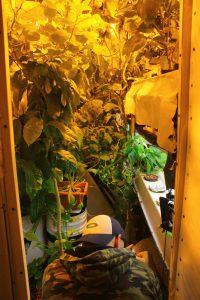
This winter, being back in the city, we have been working in a much smaller space with no natural light. This forced us to become more efficient and we are having as much if not even more fun growing our fresh vegetables.
We built our garden in a 4 feet wide hallway with mylar papers. On the ceiling we have a fan, a cooltube, an electronic ballast and a 600W Hortilux Super HPS. The first aeroponic table on top is were we put all the fruiting plants and raddishes. Underneath it we setted up six T-5 sunblaster neons. The second aeroponic table sits there filled with herbs, lettuces and young plants that will eventually move on the top table.
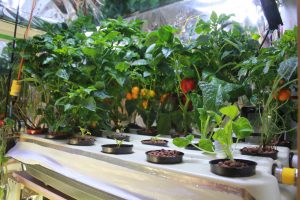 We started growing early January and already harvested raddishes, lettuces, peppers, beans and ground cherries. We use Advanced Nutrients for our recipe. We should change our soup every week but to reduce cost and push our experimentations further, we change it every month. This should limits our results but we still succeed with impressive grow rates. One of the way we achieve this is by monitoring the plants closely and adding specific nutrients at first signs of a deficiency.
We started growing early January and already harvested raddishes, lettuces, peppers, beans and ground cherries. We use Advanced Nutrients for our recipe. We should change our soup every week but to reduce cost and push our experimentations further, we change it every month. This should limits our results but we still succeed with impressive grow rates. One of the way we achieve this is by monitoring the plants closely and adding specific nutrients at first signs of a deficiency.
Two weeks ago, we added blueberry plants that had been sleeping for two months in a soil pot. We washed all the roots with icy water and put the main plant and its babies in 3 inch coco pots that fits in our aeroponic tables. The first leaves started growing after 5-7 days.
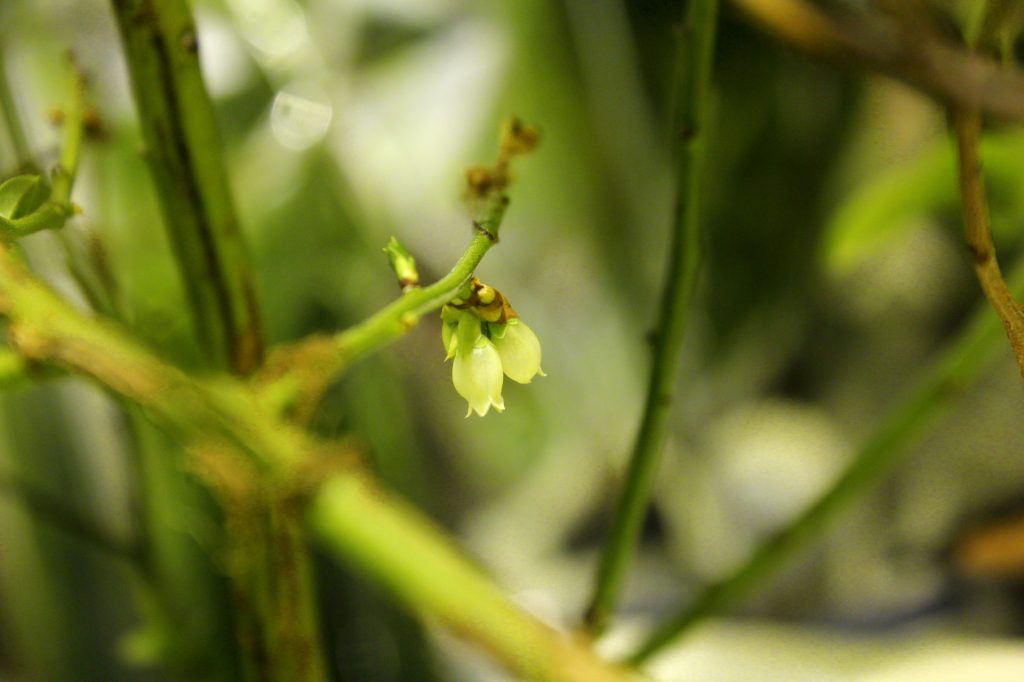 But to our most surprised delight, the aeroponic spring brought us our first blueberry FLOWERS yesterday! We are very excited to see where this leads and we hope you will be pleased to follow our progress.
But to our most surprised delight, the aeroponic spring brought us our first blueberry FLOWERS yesterday! We are very excited to see where this leads and we hope you will be pleased to follow our progress.